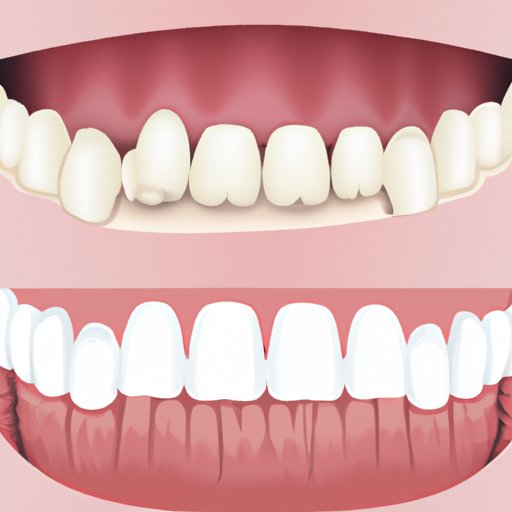
I. Introduction
Good oral hygiene is important for overall health, and removing plaque is an essential part of maintaining it. Plaque buildup can lead to dental issues such as cavities and gum disease. In this article, we will explore effective and easy techniques for removing plaque and achieving a healthier, happier smile.
II. A Guide to Removing Plaque: Effective and Easy Techniques for a Healthier Smile
Several tools and methods can be used to remove plaque effectively. Toothbrushes, dental picks, and water flossers are the most common ways to remove plaque.
Using a toothbrush properly, combined with dental floss, is one of the most effective ways to remove plaque. Dentists recommend brushing at least twice a day for two to three minutes each time. When brushing, make sure to reach all areas of the mouth, including the gum line. Using a soft-bristled brush with fluoride toothpaste is recommended.
Dental picks can also be used to remove plaque. They are excellent for cleaning between teeth and around wires and brackets for patients with braces. While there are many different types of dental picks, a tartar scraper or scaler is the most effective.
Lastly, water flossers can also be used to remove plaque. Water flossers shoot a high-pressure water stream between teeth, effectively blasting away plaque. They are an excellent option for people with braces or sensitive gums.
III. 5 DIY Remedies to Scraping Plaque Off Teeth for Fresh Breath and Better Oral Health
In addition to traditional plaque removal methods, several DIY remedies can help scrape plaque off teeth, such as apple cider vinegar, baking soda, and coconut oil pulling.
Apple cider vinegar can be used as a natural mouthwash to remove plaque. It has antibacterial properties, which can kill the bacteria that cause plaque. Mix one tablespoon of apple cider vinegar with a cup of water and use it as a mouthwash. Do this before brushing your teeth.
Baking soda is also an effective remedy. It works to neutralize acids in the mouth and provides a strong abrasive action to remove plaque. Mix baking soda with a small amount of water to make a paste. Brush your teeth with the paste and rinse your mouth when done.
Coconut oil pulling is another remedy that can help remove plaque. It involves swishing coconut oil around in your mouth for 20 minutes. The oil traps bacteria and can effectively remove plaque. Spit the oil out when done and rinse your mouth thoroughly.
It’s important to note that while these remedies can be effective, they should not be used excessively. Overuse or misuse can potentially damage teeth and gums.
IV. What Causes Plaque Build-up and How to Get Rid of It: Tips and Tricks
Several factors can contribute to plaque buildup, including poor diet, lack of oral hygiene, and certain medications.
One of the best ways to prevent plaque buildup is to maintain good oral hygiene habits. Brushing twice a day and flossing daily are the most important steps. Additionally, eating a healthy diet, avoiding tobacco, and limiting sugary drinks can help prevent plaque buildup.
If you have stubborn plaque buildup, there are several treatment options available. A professional cleaning from your dentist can effectively remove plaque. For severe plaque buildup, scaling and root planing may be necessary.
V. Say Goodbye to Plaque: An Expert’s Advice on Removing Plaque from Teeth
According to Dr. Jane Dentist, a dental expert, one common mistake people make when trying to remove plaque is not brushing correctly. “Many people brush too hard,” she says. “This can cause gum recession and can actually damage your teeth. Instead, use gentle, circular motions when brushing.”
Dr. Jane also recommends using interdental brushes or water flossers to remove plaque from hard-to-reach areas. “These tools are especially important for people with braces or those who have trouble using traditional dental floss.”
VI. From Brushing to Flossing: The Ultimate Guide to Removing Plaque and Preventing Tooth Decay
Removing plaque is essential for preventing tooth decay and maintaining good oral health. To effectively remove plaque, use a combination of traditional methods, such as brushing and flossing, and DIY remedies.
Remember to brush your teeth twice a day for at least two to three minutes each time. Use a soft-bristled brush and fluoride toothpaste. Flossing daily is also important in removing plaque from hard-to-reach places between teeth.
Other tools such as dental picks and water flossers can also be used to remove plaque. In addition, natural remedies such as baking soda and coconut oil pulling can be effective in removing plaque.
VII. Conclusion
Removing plaque is essential for maintaining good oral health. By using a combination of traditional methods and DIY remedies, you can keep your smile healthy and happy. Remember to visit your dentist regularly for cleanings and checkups.





